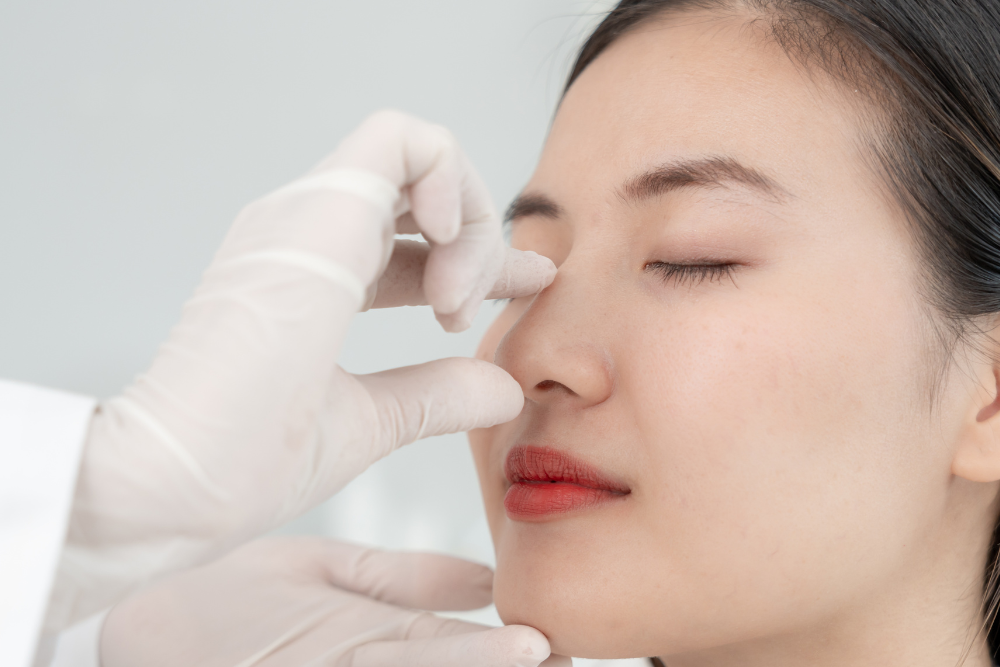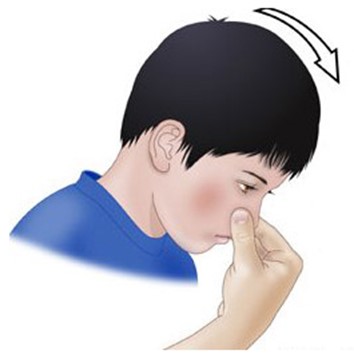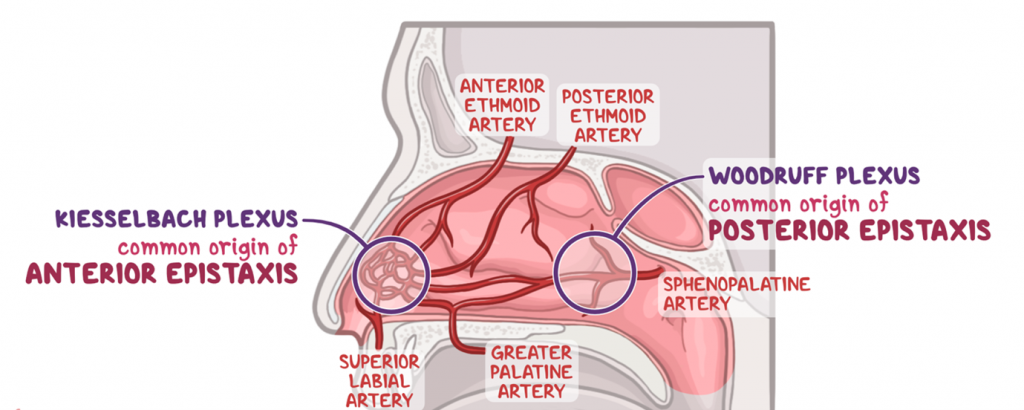





Delivering Excellence in Facial Plastic Surgery
Precision. Passion. Perfection
Safe, Artful Transformations for Your Face
Comprehensive ENT Care for Kids and Adults.
Your Family's ENT Care, Fully Addressed
Rhinoplasty: Enhancing Nasal Aesthetics
and Function.
EPISTAXIS ( NOSEBLEEDS ) TREATMENT IN SINGAPORE
NOSEBLEEDS: PATIENT INFORMATION AND FIRST AID
Nosebleeds are a common issue that can be alarming but are usually not a cause for great concern. This text aims to offer valuable information about nosebleeds, including what causes them and how to administer first aid effectively.

WHAT CAUSES NOSEBLEEDS?
Nosebleeds can occur for various reasons, including:
- Dry indoor air
- Nose picking or frequent rubbing
- Allergies
- Nasal septal spurs or deviated septum
- Blunt trauma to the nose
- Use of nasal sprays
- Underlying health conditions, such as bleeding disorders
- Nasal tumours
FIRST AID FOR NOSEBLEEDS


STEP 1: KEEP CALM
First and foremost, it’s crucial to remain calm. Nosebleeds can often look worse than they are due to the blood mixing with saliva and other fluids.
STEP 2: SIT DOWN AND LEAN FORWARD
Advise the individual to sit down and lean slightly forward. This posture helps to prevent the blood from flowing down the throat.
STEP 3: PINCH THE NOSTRILS CORRECTLY
Using a tissue or clean cloth, pinch the nostrils closed for 10 to 15 minutes. It’s essential to pinch the soft part of the nostrils together beneath the bony bridge. Avoid pinching the bony, hard part of the nose as this will not help to stop the bleeding.
STEP 4: KEEP THE HEAD ELEVATED
Keep the head elevated, even above the heart if possible. This can help reduce blood flow to the affected area.
STEP 5: APPLY A COLD COMPRESS
A cold compress on the forehead or at the back of the neck can constrict the blood vessels and help stop the bleeding more quickly.
STEP 6: RE-EVALUATE
After 10 to 15 minutes, release the nostrils gently and check if the bleeding has stopped. If it hasn’t, repeat the above steps.
WHEN TO SEEK MEDICAL ADVICE
It’s generally recommended to consult a healthcare professional if:
- The nosebleed lasts for more than 20 minutes.
- The nosebleed is accompanied by symptoms like dizziness, breathlessness or fainting.
- The individual has frequent nosebleeds.
Dr Sandeep Uppal and his team are always available for consultation and treatment for persistent or severe cases of nosebleeds.
COMMON AREAS OF NOSE BLEEDING
Understanding the common areas where nose bleeding Singapore originates can aid in effective treatment and management. Here are some insights into the typical sources of bleeding during a nosebleed.

ANTERIOR NOSEBLEEDS
Kiesselbach’s Plexus (Little’s Area)
The most common site for nosebleeds, especially in children and young adults, is the Kiesselbach’s Plexus. This is an area on the septum, which is the wall dividing the two nostrils. Blood vessels in this region are relatively close to the surface, making them prone to rupture from minor trauma, dryness, or irritation.
Nasal Vestibule
The entrance or opening of the nostrils, known as the nasal vestibule, is another common area where minor nosebleeds can originate. Causes may include nose picking, dry air, or minor injuries.
POSTERIOR NOSEBLEEDS
Sphenopalatine Artery
Less common but more severe, posterior nosebleeds often originate from the sphenopalatine artery. This artery is situated at the back of the nose and can cause more voluminous bleeding that may require medical intervention.
Branches of the Maxillary Artery
Other arteries that can be sources of posterior nosebleeds include smaller branches of the maxillary artery. These nosebleeds are often more challenging to control and may require medical treatment.
Ethmoidal arteries
These arteries are less commonly involved but can cause nosebleeds, usually in the context of trauma or surgery.
TREATMENT FOR NOSEBLEEDS
Dr Sandeep Uppal and his expert team are well-equipped to provide comprehensive care for various ear, nose, and throat conditions, including nosebleeds. While first aid measures can often manage minor nosebleeds effectively, persistent, or severe nosebleeds may require medical intervention. Here’s an overview of the treatment options available.
INITIAL ASSESSMENT
A thorough examination is conducted to determine the cause and severity of the nosebleed. This may include:
- Medical history review
- Visual inspection of the nasal cavity as part of a comprehensive ENT examination.
- Nasal Endoscopy: If nosebleeds persist and do not show signs of improvement, it’s advisable to consult an ENT specialist like Dr Sandeep Uppal to identify the site of bleeding and to eliminate concerns about more serious issues, such as nasal tumours.
A gentle examination involving the insertion of a soft, slender endoscope allows for a thorough inspection of both nasal passages and the rear of the nose. The process is generally pain-free, and most patients, including older children, find it easily tolerable.
- Blood tests (if an underlying condition is suspected)
MEDICAL TREATMENTS
Nasal Packing
If first aid measures are unsuccessful, a nasal pack may be inserted to apply constant pressure and stop the bleeding.
Cauterisation
For recurrent or stubborn nosebleeds, the blood vessel causing the issue may be cauterised using a chemical substance or electrical cauterisation procedure.
Medication
In some cases, medications such as antihistamines for allergies or topical nasal sprays may be prescribed to manage underlying issues contributing to nosebleeds.
SURGERY
Endoscopic Surgery
For severe or recurrent nosebleeds that don’t respond to other treatments, endoscopic surgery may be considered to seal off the bleeding vessel.
Ligation
In extreme cases, tying off (ligating) the blood vessel may be necessary. This is usually a last-resort option and is considered only for severe, life-threatening nosebleeds.
AFTERCARE AND PREVENTION
Dr Sandeep Uppal and his team also focus on aftercare and preventive measures, which may include:
- Recommendations for humidifiers to combat dry air.
- Instructions on proper nasal hygiene.
- Lifestyle and dietary advice, such as avoiding certain activities that could trigger nosebleeds.
AFTERCARE AND PREVENTION
Nosebleeds, while often benign, can be alarming and may require proper first aid techniques. When you encounter persistent, severe, or recurrent episodes, it’s vital to consult with experts who can provide a thorough evaluation and appropriate care. Dr Sandeep Uppal and the professional team are equipped with the knowledge and experience to address your concerns effectively.
We offer individualized care plans to manage and treat epistaxis in Singapore, ensuring you receive the highest standard of medical attention. Our goal is to understand the underlying cause of your condition and to offer treatment options that bring lasting relief.
Contact us today for more information or to schedule your appointment. Let us help you find the solution you need for peace of mind and improved well-being.
Explore our other treatments:
Snoring and Obstructive Sleep Apnoea, Allergy and Sinus Infections, Nasal Obstruction, Nose Bleeds, Ear Wax, Ear Infection, Tinnitus, Hearing Loss, Dizziness and Balance Problems, Tonsil and Adenoid Issues, Thyroid Nodules, Salivary Gland Tumours, Voice and Swallowing Disorders.


